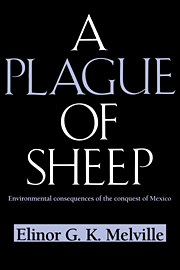Book contents
- Frontmatter
- Contents
- Illustrations and Tables
- Preface
- Chapter 1 Introduction
- Chapter 2 Alien Landscapes
- Chapter 3 The Australian Experience
- Chapter 4 The Mexican Case
- Chapter 5 The Conquest Process
- Chapter 6 The Colonial Regime
- Appendix A Sub-Areas
- Appendix B Population Estimates
- Appendix C Sources for Land Holding and Land Use
- Abbreviations
- Glossary
- Bibliography
- Index
Chapter 2 - Alien Landscapes
Published online by Cambridge University Press: 05 August 2012
- Frontmatter
- Contents
- Illustrations and Tables
- Preface
- Chapter 1 Introduction
- Chapter 2 Alien Landscapes
- Chapter 3 The Australian Experience
- Chapter 4 The Mexican Case
- Chapter 5 The Conquest Process
- Chapter 6 The Colonial Regime
- Appendix A Sub-Areas
- Appendix B Population Estimates
- Appendix C Sources for Land Holding and Land Use
- Abbreviations
- Glossary
- Bibliography
- Index
Summary
Sometime in the late seventeenth century the lands lying to the north of the Valley of Mexico received the sobriquet “el Valle del Mezquital,”, or simply “el Mezquital,”, the valley or place where mesquite grows. The Valle del Mezquital was an almost mythologically poor place renowned for its aridity, for the poverty of its indigenous inhabitants, and for exploitation by large landowners; it became the archetype of the barren regions of Mexico. Despite its notoriety, however, the Valle del Mezquital remained an ill-defined area that did not exhibit the characteristics of a region. It was not a specific administrative or a political unit, it was not associated with a clearly defined economic or agricultural system, and it was not even clearly associated with a specific geographic area. Although centered on the Tula River Valley, its boundaries could be expanded to include distinct regions such as the Tulancingo Valley to the east and Meztitlan to the north. It was not until the twentieth century that the Valle del Mezquital came to refer to a specific region.
In 1900 the floodwaters that had regularly inundated Mexico City were channeled north and fed into the Tula River and its tributaries, the Salado and Tepexi rivers. In the 1930s an irrigation district was created that used these waters, together with the waste from Mexico City, to irrigate lands in the Tula River Valley.
- Type
- Chapter
- Information
- A Plague of SheepEnvironmental Consequences of the Conquest of Mexico, pp. 17 - 59Publisher: Cambridge University PressPrint publication year: 1994

